| The Transatlantic Crossing on a Scandinavian America Line steamship | Main Page >> |
Emigrants on the Atlantic, life on board the Scandinavian America Line steamships - across the ocean in pictures
Last updated November 2008
- By Børge Solem |
|
This is a working project. The aim of the project is to document life and conditions aboard the Scandinavian America Line steamships which brought such a great number of Scandinavian emigrants across the Atlantic. We are specially looking for pictures, descriptions and accounts from the daily life aboard, but any piece if information will be of great value. If you think you can contribute please contact: webmaster@norwayheritage.com
The Scandinavian America Line was started in 1898 as a new department of the Danish steamship company "DFDS". The company took over the Thingvalla Line and continued the service between Copenhagen and New York with four of the old Thingvalla Line ships. Imediately they started a renewal of the fleet, and by 1902 the S/S Oscar II was ready for service and soon after the S/S Hellig Olav and the S/S United States were introduced.
The main route was from Copenhagen to New York via Kristiania (Oslo) and Kristiansand. The great majority of the passengers were emigrants. The Thingvalla Line had been the only Scandinavian steamship line offering a regular service between Scandinavian ports and North America since it entered service in 1880, and the Scandinavian America Line could continue this advantage for many years till the introduction of the Norwegian America Line in 1913 and the Swedish America Line in 1914. It was quite convenient for emigrants from the Northern parts of Denmark, southern parts of Sweden and Norway to travel directly, and it was considered to be a great advantage that the fares were slightly lower then the English and German lines, and not to forget - the crew and food was Scandinavian.
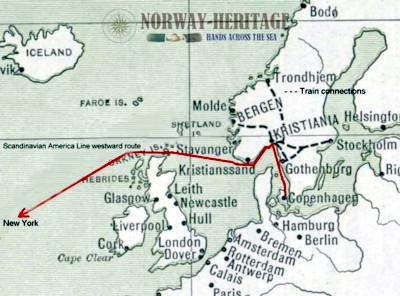 Scandinavian America Line westward route, departing Copenhagen for Kristiania (now Oslo) and then calling at Kristiansand before crossing the Atlantic. The were train connections from many other cities to the ports of departure 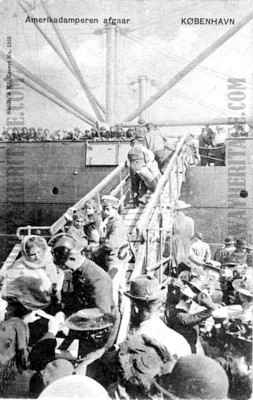
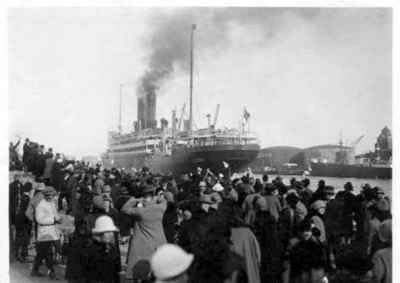
The home port of the Scandinavian America Line steamships was Copenhagen. The images above are all taken at Copenhagen. At the top left you can see the S/S Oscar II at the the Scandinavian America Line pier at Frihavnen in Copenhagen. On the top middle picture a Scandinavian America Line steamship is Passengers ready for boarding at Copenhagen. On the top right picture the S/S United States is shown berthed at Frihavnen. Bottom left picture shows passengers embarking the ship, and a policeman is checking the passengers' papers before letting them enter the gangplank. All emigrants had to show their contracts and tickets before getting on the ship, and the contracts had to be signed by the police in advance. On the last picture, bottom right, a crowd is seeing the ship off with their family and friends. The ship on the picture is the S/S Frederik VIII departing Copenhagen in October 1925. After departing from Copenhagen the ships would sail to Kristiania (Oslo), Norway to take on more passengers and cargo. (You can click any of the pictures to see the full scan in the Image Gallery)
The Scandinavian America Line ships had their piers at Vippetangen in Kristiania (Oslo), which is located near by Akershus Castle (Akershus slott) and not far from where the Oslo City Hall (Oslo rådhus) is now located. On the upper left picture the emigrant ship S/S United States is photographed as she arrives Kristiania to take aboard passengers. On the upper middle picture the S/S Oscar II is seen departing Kristiania with emigrants, and on the upper right a big crowd of people is seen as the ship is boarding passengers and making ready to depart. There were always crowds of people gethered at Vippetangen to take the last farewells with family and friends when the ships departed. The tree bottom pictures also shows ships of the Scandinavian America Line at Vippetangen. From Kristiania the ships sailed for Kristiansand to take on more passengers, before crossing the Atlantic.
At Kristiansand the ships anchored outside the harbor, as the ships were to big to enter the harbor basin. To transport passenger to and fro the ship they used small steamers as feeders. On the picture at the far left the steamship Nyland is seen carrying some of the passengers from the S/S United States at Kristiansand. On the middle left picture passengers are seen embarking the ocean liner from the feeder. As seen on the picture they were all carefully inspected by a doctor and nurse as they boarded. Their papers were also inspected by the officers on the ship. On the middle right picture a small boat is towing two barges, probably containing cargo and luggage to the S/S United States outside Kristiansand. There are also a few passengers for the ship in the small boat. On the far right picture, which was taken from the S/S United States by a passenger in 1913, the feeder is seen heading back for Kristiansand.
The conditions for the emigrants on the Scandinavian American Line steamships were fairly good. On the images top left and top middle passengers traveling on 3rd class (steerage) is seen on the deck of a a Scandinavian America Line steamship. The passengers traveling on different classes were carefully separated, and passengers from the lower classes were never allowed to visit on the spaces allotted to those of higher classes. On the other side the 1st class passengers and 2nd class passengers were not very welcome among the 3rd class passengers. On the top right picture you can see the class dining saloon on a Scandinavian America Line steamship, and on the bottom left and bottom middle picture you can see the 3rd class dining saloon where Scandinavian style meals would be served 3 times a day. The pictures were taken aboard the steamship Hellig Olav. The 3rd class passengers had a various facilities on board, and on the bottom right picture above you can see a barber saloon for 3rd class passengers on a Scandinavian America Line steamship.
The 4 first images above from the left are snapshot taken by passengers or crew who traveled on the Scandinavian America Line stamships. They all show different situations from dayly life for the passengers on 3rd class on the voyage. The first one is from a voyage on the S/S United States in May 1930, from Denmark to New York via Halifax. The second picture shows a band is entertaining the passengers on the deck of the S/S United States on a voyage in July 1913. The third and fourth picture is also taken on a voyage on board the S/S United voyage in July 1913. The last image to the right is from an old booklet and shows a 2 berth stateroom on the 3rd class as appearing on the sisters Oscar II, Hellig Olav and United States
The conditions for the passengers traveling on the 2nd and 1st class was slightly more luxurious, less crowded and more comfortable. On the picture to the left you can see some passenger passing time by playing a game of Shuffle Board on the promenade deck of the S/S United States. The next picture from the left shows the promenade deck of the S/S United States. The next piture is also from the promenade deck, and shows a band playing for the passengers resting in their deck chairs. The picture is from the steamship Hellig Olav. Next picture shows one of two "chambres de luxe" on the S/S Oscar II. The last picture at the far right shows how the the music room on the sisters Oscar II, Hellig Olav and United States appeared
The officers and crew were all on friendly terms with the passengers on the Scandinavian America Line ships. Passengers were treated friendly and were permitted to visit on the bridge upon request. The images above were taken by a passenger during such a visit. On the left picture the captain of the S/S United States (believed to be capt. R. Gøtsche) is photographed on a voyage in July 1913. The other two images are from the same voyage. A young girl is photographed beside the man at the helm on S/S United States, usually one would not let passengers disturb the man at the helm (wheel), and he would usually not be permitted to speak to any of the passengers while steering the ships.
Life was not always easy on a voyage across the Atlantic. The images above were taken by one of the officers (Peder Georg Christian Pedersen) on the Oscar II in 1911. They show scenes from a burial at sea. A Norwegian woman had died on board the ship at sea. The minister is holding a service, the body was covered by a Norwegian flag, and was lowered into the ocean after the service, leaving the mourning relatives without a grave other then the great ocean
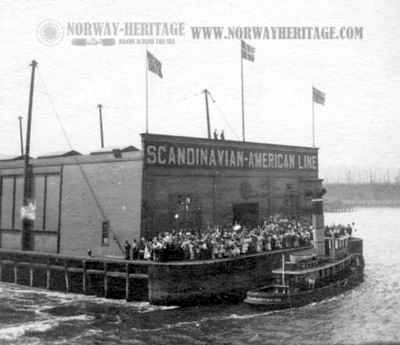
When the ships arrived at New York they docked at the Scandinavian America Line dock in Hoboken. It was situated at foot of 17th Street Hoboken N.J. To reach the doc from New York people had to take the W. 23rd Street Ferry to 14th Street in Hoboken. On the picture above a passenger has photographed the pier from the deck of the S/S United States she was pulling in. The emigrants would be taken from the Scandinavian America Line dock to Ellis Island by ferry boats or barges to be processed through the emigration control. The photo was taken on a voyage in July 1913.
On the left image above you can see the emigrants coming up the board-walk from the barge which had taken them off the steamship company docks and transported them to Ellis Island. The building in the background is the hospital. In the middle of the picture you see the ferry boat running to New York. On the picture in the middle you see a view of the interior of the main building at Ellis Island, showing the detention pens and emigrants passing doctors for examination. On the picture to the right the transport Hazel Kirk is departing Ellis Island with discharged emigrants to take them across to the Fall River Line Pier in New York
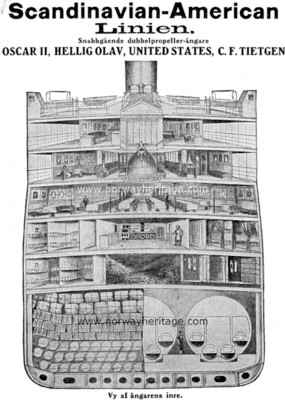 Sectional view of the sisters Oscar II, Hellig Olav and United States
You can find more images in the different sections of the Norway Heritage Image Gallery
|
|
|
|
The Norway Heritage web site is a culmination of hard work and commitment to providing FREE access to material concerning our heritage. Maintaining a non-profit project requires some kind of financial support. By making a donation you will help keep this site the great resource that it is! It will also ensure your visits remain popup and banner ad free. Help us add more stuff to the emigrant trunk. Please support this free resource!
|
|
|
|
|
